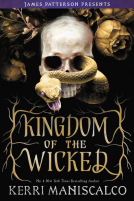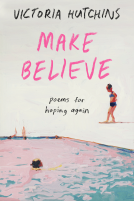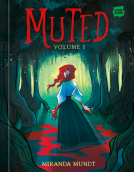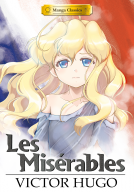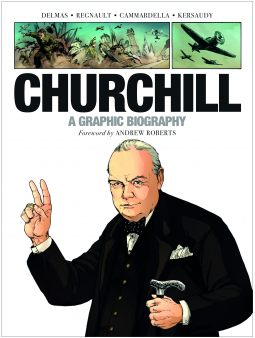
Churchill
A Graphic Biography
by Written by Vincent Delmas; Illustrated by Christophe Regnault and Alessio Cammardella; Foreword by Andrew Roberts
This title was previously available on NetGalley and is now archived.
Send NetGalley books directly to your Kindle or Kindle app
1
To read on a Kindle or Kindle app, please add kindle@netgalley.com as an approved email address to receive files in your Amazon account. Click here for step-by-step instructions.
2
Also find your Kindle email address within your Amazon account, and enter it here.
Pub Date Apr 15 2020 | Archive Date Apr 15 2020
Talking about this book? Use #Churchill #NetGalley. More hashtag tips!
Description
Sir Winston Churchill is often referred to as the greatest Briton and is certainly one of the most important and central figures of the 20th century. Containing both his many pitfalls and triumphs, this graphic biography follows Churchill’s upbringing, through his military exploits in World War I and beyond.
Best known for his role in the World War II, Churchill presents the Prime Minister’s part in this world-changing conflict and how his handling of it turned him into a political icon. Leading Churchill historian Andrew Roberts contributes additional insight in the foreword and historian François Kersaudy provides a new English-language introduction to provide greater background and supplementary knowledge.
Churchill is a unique depiction of the life of Winston Churchill that places his story in the context of the times while enabling the reader to truly visualize the key moments in his life and career.
Advance Praise
“A wholly original and fresh approach to historical biography. Churchill would have been delighted to be a comic book hero!” —Phil Reed, Emeritus Director, Churchill War Rooms
“A novel and riveting re-telling of the Churchill legend.” —Professor Gary Sheffield, author of Douglas Haig: From the Somme to Victory
Available Editions
| EDITION | Paperback |
| ISBN | 9781682475287 |
| PRICE | $19.95 (USD) |
Links
Featured Reviews
 Natalie H, Reviewer
Natalie H, Reviewer
I received an advanced reader copy of this book to read in exchange for an honest review via netgalley and the publishers.
This is a fantastic graphic novel about one of the most historically remembered and important figures in british history to date.
I learnt alot of valuable information from this book about Winston Churchill that i didnt know before.
The book takes us through Winston Churchill's life from childhood and his upbringing through to his military experience and background and experiences during the 1st world war.
This is a great informal book for anyone wanting to learn about this great man in a more inventive and memorable format.
I'm a big fan of Churchill so I was happy to receive this ARC from NetGalley in exchange for an honest review. The story itself was very entertaining. Seeing Churchill as a child and younger man was especially interesting since we always see him as an elder gentleman. The drawing style was very fitting for the settings and historical time and the colors nice and calm - it didn't pop and made the story look like a comic.
There's a lot of heavy dialogue and small pieces of text. It seems a bit much for this type of visual format but other than that, it was very entertaining.
Churchill: A Graphic Biography is my second Graphic Novel.
Many of us have watched various documentaries and movies about Winston Churchill as he is such a well-known historical figure. In fact, one could argue if it wasn’t for Churchill standing up to the evil of Adolf Hitler (when many wouldn’t) the western world quite possibly would have fallen to Nazism. The last Churchill biography I read was The Churchill Factor - written by the effervescent Boris Johnson (yes, he of the foppish hair, which was an excellent biography and I highly recommended it. I therefore came to this Graphic Novel with a smidgeon of knowledge about the subject.
This book covers his life from that of a little boy running around Blenheim Palace (his birthplace) in 1880 to the end of WW2 in 1945. This guy packed so, so much into this life. He was descendant of the Duke of Marlborough line, his father was Conservative MP Lord Randolph Churchill – so Winston was from aristocratic stock. He also participated in numerous wars in places like Cuba, India, Sudan and South Africa, this was followed by his time as a parliamentarian where he managed to swap teams (twice) and was known as an outspoken, unruly, opinionated man with very few friends. But he had a massive intellect and mind. He held various senior posts in Government such as First Lord of the Admiralty, Secretary of State for War, Minister for Munitions and Chancellor of the Exchequer and a few others. He ended up being Prime Minister after Britain decided they had enough of appeasing Hitler and needed someone to stand up to him. Well, Winston was your man – has was a fighter. He was also an accomplished painter, bricklayer (a hobby - of all things), writer and journalist, historian and orator.
Okay there is so much a book needs to cover if they want to do this giant of a man justice. Probably easier to cram his full story using words into a 500-600 page book as compared to 120 pages of pictures with speech bubbles in a Graphic Novel. Well these guys did it, they really did.
The writing was on point, as was the artwork. In fact, the artwork was superb. The pictures almost came alive in front of your eyes. Now, I am not sure my previous reading filled in any gaps – that’s hard to tell – but the team Vincent Delmas, Christophe Regnault et al hit the significant points in this period of his life very nicely indeed. But I would have liked a little more about his wife Clementine and their relationship, even if it was a couple more scenes – small criticism.
Some of my enduring images and takeaways of this delightful book include:
• Winston was a prolific drinker. Particularly in the latter part of the book, a champagne or whiskey glass was forever in his hand
• His desire to fight – whether it be politics or war. He wanted to be right in the middle of it.
• Winston loved giving free advice, to anyone.
• His Dad wasn’t what you’d describe as a helicopter parent.
• It’s lucky he didn’t die during the number of conflicts he participated in.
• The ‘pissing scene’ on the Siegfried line towards the end of WW2.
• His suspicion of Stalin and Communists in the post-war period.
You’ll also receive a good supply of Churchillian quotes, you will see the usuals – but my favourite this time was “When I was younger, I made it a rule never to take strong drink before lunch. It is now my rule never to do so before breakfast.”
I will give this book 5 stars as I enjoyed it so much, and isn’t that what it’s all about? I had a ball – and for those new to him, what a great place to start.
Enjoy.
5 Stars
Many thanks to Netgalley for providing me with a copy of this book in return for an unbiased and fair review.
THIS is what an historical graphic novel should be! the introduction gives solid context and establishes the depth of the writers' intent. The illustrations are nothing short of jaw-dropping. In one sitting, readers are able to encounter the personality and the times of a huge figure in 20th century world history. Highly recommended.
 Andrew D, Reviewer
Andrew D, Reviewer
Winston Churchill is a figure well-known to people all over the world. He has been hailed as the man who saved the West, led Britain to victory in WWII, and there have been over 1000 (actually 1010) biographies written about him. Yet none of these biographies have illustrated the life of Winston Churchill, rather they have told it. In association with the Naval Institute Press, writer Vincent Delmas and artist Christopher Regnault capture Winston Churchill’s life combining visual imagery with text in their new graphic novel, Churchill.
Summary:
The graphic novel focuses on Churchill’s drive towards glory. Beginning in 1880 a young Churchill residing at Blenheim Palace learns his ancestor, John Churchill, defeated Louis XIV at Blenheim in 1704. As a result, Queen Anne rewards John by making him the first Duke of Marlborough and granting him a palace at Blenheim. Intrigued by the Duke of Marlborough’s success, Winston begins to seek glory as his ancestor did. This quest is only reinforced by his father, Lord Randolph Churchill, who was an articulate speaker, thinker, and well-respected figure within the House of Lords. In order to achieve the prestige of both his father and the Duke of Marlborough, Churchill realizes that he will join the Army. After graduating twentieth in his class from Sandhurst Churchill uses his mother’s connections to secure placements in different military areas around the world. This is done with the full intention of becoming a member of Parliament and to surpass the glory his ancestors achieved.
Churchill became a member of Parliament in 1900 and by 1904 Churchill began to criticize aspects of his own Conservative Party. In 1908, after switching to the Labour party, Churchill became the First Lord of the Admiralty. He foresaw Germany becoming a problem and began to make plans to revolutionize the Navy. This included having more ships with larger guns, and planes all to prepare for the conflict with Germany. As the war starts with Germany and wears on with lack of progress Churchill is removed from power and defamed through a false report. In 1916, the Conservative Party regains power in the government and releases a report clearing Churchill’s name. Returning to government he introduces the concept of a tank which allows for twenty-seven miles to be gained on the war front for the cost of six million pounds. With this addition, he is tasked to convince America to join World War I and fight alongside the United Kingdom, which he successfully does.
Upon winning the Great War (WWI), Winston Churchill has the foresight to realize that the Treaty of Versailles is going to fail. Yet, he is powerless to do anything about it as his colleagues effectively made him a back bencher. In 1932 Churchill realigned himself with the Conservative Party, where he was once again challenging his own party’s policies and actions.
At the onset of World War II Great Britain’s practice of appeasement not working, Churchill was brought back to his old position as Lord of the Admiralty in 1939. By May of 1940 Churchill became the new Prime Minister and mobilizes troops against the Germans. Initially, under his leadership as Prime Minister, Britain faced several defeats including having to retreat at Dunkirk and France surrendering to Germany. Despite these losses Churchill inspired and kept both his troops and citizens optimistic as the battle progressed onto UK soil. While publicly leading his troops, Churchill was also privately convincing President Roosevelt to provide money and destroyers to help the British fight off Hitler.
As WWII progressed luck struck for Churchill three times. The first being that the British had cracked the code on the secret messages the Germans were sending to their troops. Hitler had broken a nonaggression pact with Stalin, causing a 2-front war for Germany. Japan, an ally of Germany, attacked America, pushing the United States to join the war.
In 1944 the United States, the United Kingdom and French troops under Charles de Gaulle, participated in a joint operation known as D-Day. Despite the number of soldier’s lost, D-Day was a successful operation and was the start of the end of the war for Germany. Knowing this Roosevelt choose to allow Stalin to claim Berlin, rather than risk more loss of life for the United States. After victory was claimed, Berlin and Germany were divided into sections, one under the control of the Allied forces and the other under the control of Russia. Churchill, who had a great work and friendship with FDR, was furious with Roosevelt’s decision not to claim victory as a means to stop communism. With these two groups now controlling Germany, no thanks to Roosevelt, Churchill understood that Nazism had been just been replaced by the new threat of Communism.
Significance:
There is a difference between telling history and showing history and the graphic novel, Churchill, illustrates the journey of Winston Churchill from his childhood to becoming Prime Minister of Britain during the world’s most trying time. This is done in a variety of ways starting with showing us the initial motivation for Winston Churchill to want to become involved in public service reflecting the accomplishments of his ancestor John Churchill and his father Lord Randolph. Regault’s illustrations combine with Dalmas text show us the flavor of Winston Churchill’s personality throughout the novel. You can see Churchill as he develops from childhood into adulthood and how he is less interested in living up to his family’s name and more concerned with preserving democracy not only for his country, but for the world.
Dalmas and Regault present the biography in an academic way we do not lose any of the history in the graphic novel format. The novel shows the expression on Churchill’s face as he debates in Parliament and stands firm on what he believes in. We see his motivation and his drive and the difficult decisions depicted in the illustrations. You can see the frustration on Churchill’s face when FDR would not commit to full capture of Germany because he saw that this decision would not stop the spread of Communism.
Churchill is a well-done biography. Presented in the graphic novel format it offers a different perspective of Winston Churchill’s life. Regault and Dalmas capture Winston Churchill as one of the most important democratic leaders of the twentieth-century. He not only saved Great Britain, but he saved the entire world from falling to Nazi Germany.
Readers who liked this book also liked:
Jason Chatfield; Scott Dooley
Comics, Graphic Novels, Manga, Entertainment & Pop Culture



